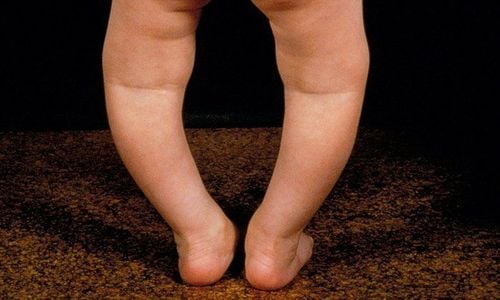This is an automatically translated article.
Rickets in children is common from infancy to under 3 years of age. The main cause is a lack of Vitamin D, leading to the body not being provided with enough calcium and phosphorus necessary for comprehensive development.1. Rickets in children
Rickets in children occurs when the baby's body lacks the necessary amount of vitamin D. Vitamin D deficiency affects the absorption and metabolism of two important substances that help bones develop, calcium and phosphorus.
Rickets in children is common in the first 3 years of life, which is mainly caused by a lack of sunlight, or a diet with insufficient calcium - phosphorus and not being exclusively breastfed. If the disease is serious, the child's skeleton can be deformed. Babies who are most at risk for rickets fall into the following groups:
Premature babies or twins Who are given cow's milk instead of breast milk Are overweight, too plump Children with dark skin Babies born in places where cloudy weather conditions, lack of sunlight In addition to rickets, there is also the concept of stunting to refer to children who are malnourished, both weight and height are below average, may be accompanied by rickets or are not. Meanwhile, there are cases of rickets also seen in very plump children because these babies have a higher need for calcium - phosphorus supplements than those with a normal growth index.
2. The telltale signs
Rickets in children often manifests through some of the following signs:
Children often cry, sleep restlessly, startle easily, and sweat a lot while sleeping. Hair loss a lot, especially in the back of the neck like a turban. Abnormalities in the skull, including wide and soft fontanelle, incomplete fontanelle, and pulsation with breathing; appearance of a hump on the top of the head, a hump on the forehead (bulging forehead), or a flattened head that looks like a catfish. Teeth are slow to grow, dystonia or constipation. Slow motor development such as rolling, flipping, crawling, walking, standing... In case of acute rickets, children may have convulsions due to low calcium levels in the blood. Severe rickets carries a risk of complications such as: bead necklaces in the ribs, malformations of the chicken breastbone, also known as a convex breast, and bow legs.

Chân vòng kiềng là một trong những biến chứng của còi xương ở trẻ
3. Treatment of rickets in children
If parents notice that their child has the above symptoms, they need to take the child to a nutrition center or a pediatric hospital to be examined and diagnosed by a doctor. For children who have been diagnosed with rickets, the main treatment method is focused on the main cause, which is vitamin D and calcium supplements.
3.1. Sun exposure for children every day
In the human body, there is a precursor for vitamin D located under the skin, called 7-dehydro-cholesterol. The impact of ultraviolet rays in the sun causes the above precursor to be activated, and then forms vitamin D. Vitamin D helps regulate calcium and phosphorus in the blood, which is easily absorbed and metabolized.
The ideal and safest time for children to sunbathe is before 9 am and within about 10-30 minutes. In areas that lack sunlight, the child may be referred to the physical therapy department at the hospital for an artificial light bath as an alternative therapy. When exposed to the sun, children should be restrained from wearing many clothes so that the sun's rays are shined directly on the skin, not through the fabric or the glass window to maximize the effect.
3.2. Provides vitamin D and calcium
Oral or injected vitamin D: The reference dose of vitamin D is 4000 UI/day for 4 - 8 weeks. However, it is still necessary to follow the doctor's instructions because in some cases the child has pneumonia, diarrhea or depends on the different body condition, the level of vitamin D can be adjusted. In addition, it can also be given to the child. vitamin D injection 200,000 UI/oral, booster injection interval is 3 months and lasts for 1 year. Supplementing with calcium by preparations: B1 - B2 - B6 calcium tube orally is another option that can be considered to increase the daily supply of vitamin D for children. Reasonable and scientific nutrition: For infants, they should be exclusively breastfed. When it comes to weaning, parents should pay attention to choose calcium-rich foods such as milk and seafood in the daily menu. In addition, it should be noted that the notion that feeding children stewed bones will prevent rickets is incorrect. Instead, fats and oils will help children absorb vitamin D because they are fat-soluble. If the daily meal is lacking in fat, there is a risk that rickets will not be cured in children even though they are given adequate oral and injection of vitamin D.

Các món canh xương ống hầm không giúp trẻ chống lại bệnh còi xương
4. How to prevent rickets in children
To prevent children from being deficient in Vitamin D leading to rickets, pregnant women should limit hard work, arrange reasonable rest time to avoid premature birth. You should take vitamin D supplements at the 7th month of pregnancy at the dose prescribed by your doctor.
After giving birth, both mother and child should not be too abstinent, instead, prioritize staying in a cool room and full of sunlight. Moreover, 2 weeks old baby can start sunbathing 15-20 minutes a day before 9am. In addition, parents need to consult with their doctor before giving children vitamin D supplements during the first years of life. For children in the weaning stage, calcium-rich foods such as milk, eggs, seafood, green vegetables and fats should be prioritized.
Rickets in children is a disease that no parent wants. However, to prevent rickets is not too complicated, any parent can follow the above instructions to ensure the health and comprehensive development of their children. Besides, it is also necessary to observe the signs from infancy to adulthood to identify whether your child is deficient in Vitamin D, thereby taking timely treatment measures, bringing positive effects.
Please dial HOTLINE for more information or register for an appointment HERE. Download MyVinmec app to make appointments faster and to manage your bookings easily.













